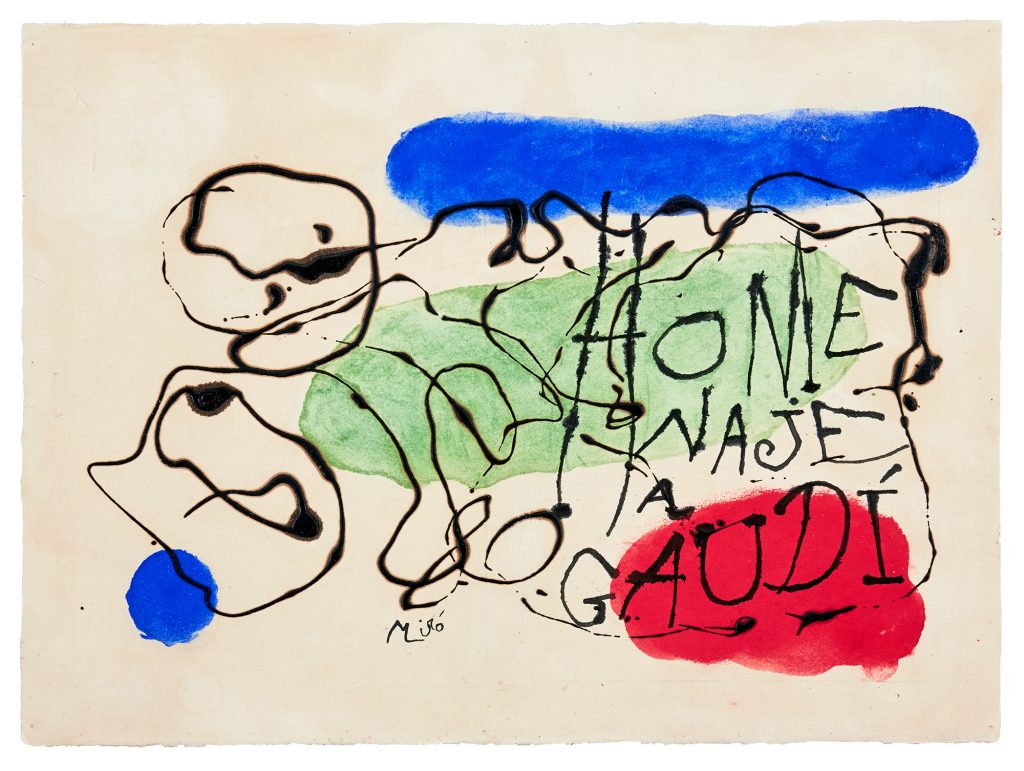Aktuella auktioner
Se datum och information

Hammered for SEK 300.000 at Uppsala Auktionskammares Important Sale 13-15 June 2018
362. Joan Miró (Spain 1893‑1983). ”Homenaje a Gaudí (Homage to Gaudí)”. Signed Miró. Gouache, watercolour, brush, ink and oil on paper, 28.5 x 38.5 cm.
Executed in 1959.
The authenticity of this work has been confirmed by ADOM, Paris (Association pour la Défense de l’œuvre de Joan Miró).
Provenance:
Galerie Emilio Arditti, Paris.
An important Swedish Private Collection, acquired from the above.
Exhibited:
Liljevalchs konsthall, Stockholm, ”Miró”, exhibition catalogue no. 305, 30 September-29 October 1972, cat. no. 18.
Literature:
The present work is featured on the cover of a literary review by Camilo José Cela, “Papelles de son armadans”, which is included with this lot. Camilo José Cela was the Spanish winner of the Nobel prize in literature in 1989.
The Catalan master Joan Miró is regarded to be one of the most innovative artists of the 20th century and a pioneer of the surrealist movement. In 1920 he moved to Paris from his hometown Barcelona and the encounter with the avant-garde artists in the French capital inspired him to more modern expressions, and eventually he officially joined the Surrealists in 1924. Throughout his long and productive career, Miró constantly undertook new challenges and even in his later years his artistic expressions kept evolving.
”Homenaje a Gaudí (Homage to Gaudí)” was executed in 1959. Only a few years earlier in 1956, Miró had permanently settled with his wife Pilar in Mallorca and managed to secure the studio he had always wanted, an enormous space in the capital of the island. During these years and through the 1960’s he focused almost exclusively on printmaking and ceramics and created several different motifs, of which many related to his beloved Barcelona. The vision of the famous Catalan architect Antoni Gaudí was highly admired by Joan Miró and by spending most of his life in Barcelona, Miró had the opportunity to visit many of Gaudí’s main works. The monumental buildings designed in a modern gothic style greatly inspired him as an artist and when creating this vivid composition in the late 1950’s, Miró honoured the work of the great master. ”Homenaje a Gaudí (Homage to Gaudí)” was featured on the cover of the literary review ”Papelles de son armadans” by Camilo José Cela, the Spanish winner of the Nobel prize in literature in 1989. In an interview with Yvon Taillandier in 1959, the same year he created ”Homenaje a Gaudí (Homage to Gaudí)”, Miró explained: “I work in a state of passion and excitement. When I begin a painting, I am obeying a physical impulse, a necessity to begin. It’s like receiving a physical shock… Even more important than the painting itself is what it gives off, what it projects… a painting must give off sparks. It must give birth to a world”.

Joan Miró, Antoni Tàpies, Joan Prats and Teresa Tàpies photographed in Mallorca.
To some extent, contemporary American artists also influenced Miró’s work. The bold black brushstrokes seen in the work included in this sale reminiscent of abstract expressionism and action painting, movements that flourished in New York after World War II. Whilst in New York in 1959, where Miró had travelled on the occasion of his second major retrospective at the Museum of Modern Art, he was exposed to works by some of his contemporary American artists. Initially, Miró had inspired many of the artists he saw during his time in New York, such as Jackson Pollock, Franz Kline and Robert Motherwell. This time, it was the other way around and Miró returned to Mallorca deeply fascinated by his experiences in New York. In J. Dupin’s book “Miró” from 1993 Miró was quoted telling about his trip to America and the impact the works by American artists had on him: ”It showed me the liberties we can take, and how far we could go, beyond the limits. In a sense, it freed me”.
The 1950’s and the following decades marked important years for Joan Miró as he continued to receive international recognition through numerous retrospectives and awards. In 1954 he was given the Venice Biennale printmaking prize and in 1958, he received the prestigious Guggenheim International Award for his murals in Paris. Only a few years before he passed away, he was awarded the Spanish Gold Medal for Fine Arts by King Juan Carlos. Today, his works are held in some of the most prestigious museum collections in the world such as The Museum of Modern Art in New York, the Tate Gallery in London, the Art Institute of Chicago and the Fundació Joan Miró in Barcelona as well as in important private collections worldwide.